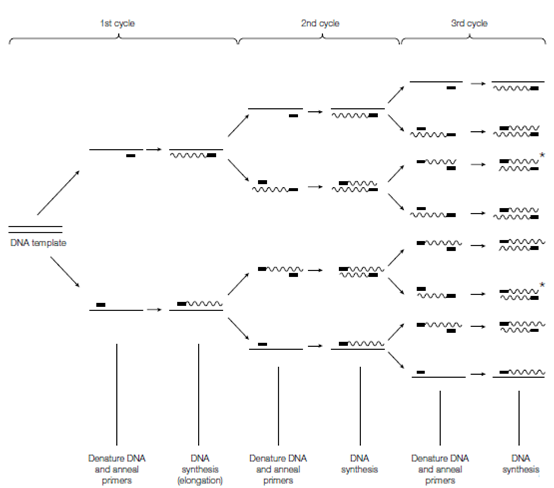PCR consists of three steps:
- Denaturation. The reaction combination is heated to 95°C for a short time period (about 15-30 sec) to denature the goal DNA into single strands which can act as templates for DNA synthesis.
- Primer annealing. The mixture is rapidly cooled to a described temperature that permits the two primers to bind to the sequences on every of the two strands flanking the goal DNA. This annealing temperature is calculated carefully to ensure in which the primers bind only to the desired DNA sequences. Each primer binds to each strand. Two parental strands do not reanneal with each other because the primers are in huge excess over parental DNA.
- Elongation. The temperature of the mixture is raised to 72°C (commonly) and kept at this temperature for a preset period of time to permits DNA polymerase to elongate every primer through copying the single-stranded templates. At the last of this incubation both single-stranded template strands have been made partially double stranded. The new strand of every double-stranded DNA extends for a variable distance downstream.
These three steps of the PCR cycle are repeated. Therefore in the second cycle, the four bind, primers, strands, denature and are extended. No other reactants required to be added. The three steps are repeated once more for a third cycle and so on for a set number of further cycles. By the third cycle, some of the PCR products (indicated by asterisks in the figure) Represent DNA sequence only between the two primer sites and the sequence does not extend beyond these sites. As the more and more reaction cycles are carried out, this type of double- stranded DNA molecule becomes the majority species present. After each 20 cycles,

Figure: The polymerase chain reaction (PCR). Asterisks indicate the first PCR products that arise (in the third cycle) which consist of DNA sequence only between the two primer sites.
the real DNA has been amplified a million-fold and this increased to a billion- fold 1000 million after 30 cycles. At that point the huge majority of the products are identical in which the DNA amplified is only which among the two primer sites. The Automated thermocyclers are now routinely used without manual interference to cycle the reaction so in which a billion-fold amplification of the DNA sequence among the two primer sites 30 cycles can take less than one hour!